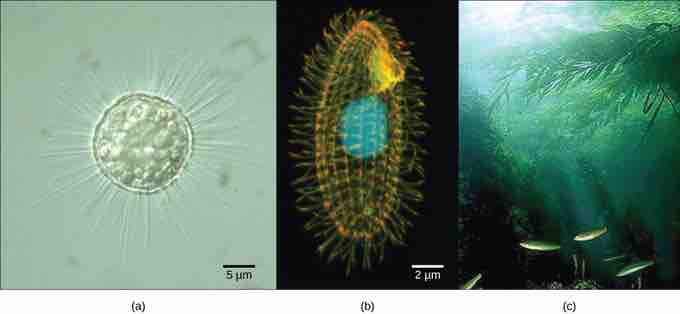Origins of Eukaryotes
Humans have been familiar with macroscopic organisms (organisms big enough to see with the unaided eye) since before there was a written history. It is likely that most cultures distinguished between animals and land plants, but most probably included the macroscopic fungi as plants. Therefore, it became an interesting challenge to deal with the world of microorganisms once microscopes were developed a few centuries ago. Many different naming schemes were used over the last couple of centuries, but it has become the most common practice to refer to eukaryotes that are not land plants, animals, or fungi as protists.
Most protists are microscopic, unicellular organisms that are abundant in soil, freshwater, brackish, and marine environments. They are also common in the digestive tracts of animals and in the vascular tissues of plants. Others invade the cells of other protists, animals, and plants. Not all protists are microscopic. Some have huge, macroscopic cells, such as the plasmodia (giant amoebae) of myxomycete slime molds or the marine green alga Caulerpa, which can have single cells that can be several meters in size. Some protists are multicellular, such as the red, green, and brown seaweeds. It is among the protists that one finds the wealth of ways that organisms can grow. They are among the first organisms to evolve with the rise of eukaryotes.
Eukaryotes in a Geological Time Frame
The oldest fossil evidence of eukaryotes, cells measuring 10 µm or greater, is about 2 billion years old. All fossils older than this appear to be prokaryotes. It is probable that today's eukaryotes are descended from an ancestor that had a prokaryotic cellular organization. The last common ancestor (LCA) of today's Eukarya had several characteristics that included: cells with nuclei that divided mitotically and contained linear chromosomes where the DNA was associated with histones; a cytoskeleton and endomembrane system; and the ability to make cilia/flagella during at least part of its life cycle. The LCA was aerobic because it had mitochondria that were the result of an aerobic alpha-proteobacterium that lived inside a host cell. Whether this host had a nucleus at the time of the initial symbiosis remains unknown. The LCA may have had a cell wall for at least part of its life cycle, but more data are needed to confirm this hypothesis. Today's eukaryotes are very diverse in their shapes, organization, life cycles, and number of cells per individual.
While today's atmosphere is about one-fifth molecular oxygen (O2), geological evidence shows that it originally lacked O2. Without oxygen, aerobic respiration would not be expected; living things would have relied on fermentation instead. At some point before about 3.5 billion years ago, some prokaryotes evolved the ability to photosynthesize. Cyanobacteria used water as a hydrogen source and released O2 as a waste product. Originally, oxygen-rich environments were probably localized around places where cyanobacteria were active, but by about 2 billion years ago, geological evidence shows that oxygen was building up to higher concentrations in the atmosphere. Oxygen levels similar to today's levels only arose within the last 700 million years. Recall that the first fossils that we believe to be eukaryotes date to about 2 billion years old, so they appeared as oxygen levels were increasing.

Protist varieties
Protists range from the microscopic, single-celled (a) Acanthocystis turfacea and the (b) ciliate Tetrahymena thermophila, both visualized here using light microscopy, to the enormous, multicellular (c) kelps (Chromalveolata) that extend for hundreds of feet in underwater "forests. "